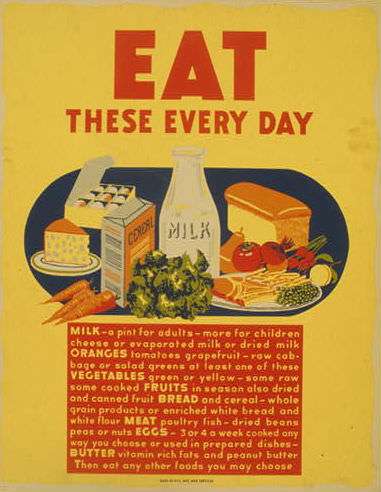The Top 5 Lies About Biotech Crops
Don't believe the anti-biotech hype.
The Institute for Responsible Technology, an organization opposed to crop biotechnology, has published a list of reasons to avoid GMOs—that is, genetically modified food. It's a mish-mash of misinformation and disinformation. All of the institute's assertions are unfounded, but here are the five most dubious claims on the list.
1. GMOs Are Unhealthy
Every independent scientific body that has ever evaluated the safety of biotech crops has found them to be safe for humans to eat.

A 2004 report from the National Academy of Sciences (NAS) concluded that "no adverse health effects attributed to genetic engineering have been documented in the human population." In 2003 the International Council for Science, representing 111 national academies of science and 29 scientific unions, found "no evidence of any ill effects from the consumption of foods containing genetically modified ingredients." The World Health Organization flatly states, "No effects on human health have been shown as a result of the consumption of such foods by the general population in the countries where they have been approved."
In 2010, a European Commission review of 50 studies on the safety of biotech crops found "no scientific evidence associating GMOs with higher risks for the environment or for food and feed safety than conventional plants and organisms." At its annual meeting in June, the American Medical Association endorsed a report on the labeling of bioengineered foods from its Council on Science and Public Health. The report concluded that "Bioengineered foods have been consumed for close to 20 years, and during that time, no overt consequences on human health have been reported and/or substantiated in the peer-reviewed literature."
Unfortunately there is no shortage of fringe scientists to gin up bogus studies suggesting that biotech crops are not safe. My personal favorite in this genre is Russian researcher Irina Ermakova's claim, unpublished in any peer-reviewed scientific journal, that eating biotech soybeans turned mouse testicles blue.
One widely publicized specious study (also cited by the IRT) was done by the French researcher Gilles-Eric Seralini and his colleagues. They reported that rats fed pesticide resistant corn died of mammary tumors and liver diseases. Seralini is the president of the scientific council of the Committee for Research and Independent Information on Genetic Engineering, which describes itself as an "independent non-profit organization of scientific counter-expertise to study GMOs, pesticides and impacts of pollutants on health and environment, and to develop non polluting alternatives." The Committee clearly knows in advance what its researchers will find with regard to the health risks of biotech crops. But when truly independent groups, such as the European Society of Toxicologic Pathology and the French Society of Toxicologic Pathology, reviewed Seralini's study, they found it essentially to be meretricious rubbish. Six French academies of science issued a statement declaring that the journal should never have published such a low-quality study and excoriating Seralini for orchestrating a media campaign in advance of publication. The European Food Safety Agency's review of the Seralini study "found [it] to be inadequately designed, analysed and reported."
Sadly, such junk science has real-world consequences, since Seralini's article was apparently cited when Kenya made the decision to ban the importation of foods made with biotech crops.
2. GMOs Increase Herbicide Use
First, so what? This claim is simply an attempt to mislead people into thinking that more herbicide use must somehow be more dangerous. As a U.S. Department of Agriculture report has noted, planting herbicide resistant biotech crops enables farmers to substitute the more environmentally benign herbicide glyphosate (commercially sold as Round Up) for "other synthetic herbicides that are at least 3 times as toxic and that persist in the environment nearly twice as long as glyphosate." Glyphosate has very low toxicity, breaks down quickly in the environment, and enables farmers to practice conservation tillage, which reduces topsoil erosion by up to 90 percent. So the net environmental effect is still positive.

Second, it must be admitted that there are few honest brokers when it comes to this issue. Most of the research on biotech crops and herbicides is underwritten by either activist groups or industry. I have drawn my own conclusions, but I provide a fairly comprehensive review of the various studies on this question below.
When it comes to biotech crops and pesticide use data, the go-to guy for anti-biotech activists is Charles Benbrook. After a long career with various anti-biotech groups, Benbrook now serves as a research professor in the Center for Sustaining Agriculture and Natural Resources at Washington State University. He has a long history of publishing studies allegedly showing that the adoption of biotech crops boosts the use of pesticides. Four years after commercial biotech crops were first planted in the United States, for example, he concluded in 2001 that herbicide use had "modestly increased." Benbrook's article contradicted research published the year before by scientists with the U.S. Department of Agriculture, who had found that biotech crops had reduced pesticide applications.
In a 2004 report funded by the Union of Concerned Scientists, Benbrook asserted that "GE [genetically engineered] corn, soybeans, and cotton have led to a 122 million pound increase in pesticide use since 1996." In contrast, a 2005 study in Pest Management Science, by a researcher associated with the pesticide lobby group CropLife, reported that planting biotech crops had "reduced herbicide use by 37.5million lbs." A 2007 study done for the self-described non-advocacy think tank National Center for Food and Agricultural Policy, founded in 1984 by the W.K. Kellogg Foundation, reported that planting biotech crops in the U.S. had reduced in 2005 herbicide use by 64 million pounds and insecticide applications by about 4 million pounds. Another 2007 study, by a team of international academic researchers led by Gijs Kleter from the Institute of Food Safety at Wageningen University in the Netherlands, concluded that in the U.S., crops genetically improved to resist herbicides used 25 to 30 percent less herbicides than conventional crops did. In 2009, Benbrook issued a report for the anti-GMO Organic Center claiming that "GE crops have been responsible for an increase of 383 million pounds of herbicide use in the U.S. over the first 13 years of commercial use of GE crops."
Benbrook's latest study, issued last year, found that the adoption of pest-resistant crops had reduced the application of insecticides by 123 million pounds since 1996 but increased the application of herbicides by 527 million pounds, an overall increase of about 404 million pounds of pesticides. The media—including Mother Jones' ever-credulous anti-biotech advocate Tom Philpott— reported these results unskeptically.
Benbrook largely got his 2012 results by making some strategic extrapolations of herbicide use trends to make up for missing data from the U.S. Department of Agriculture. In fact, the USDA does not provide herbicide use data for corn in 2004, 2006, 2007, 2008, 2009, or 2011, for soybeans in any year after 2006, and for cotton in 2002, 2004, 2006, 2009, and 2011. (The USDA's National Agricultural Statistics Service is expected to issue a report updating national herbicide and insecticide usage later this year.)
As the University of Wyoming weed biologist Andrew Kniss points out, in order to get an increasing herbicide trend, Benbrook's extrapolations turned a negative herbicide use trend for corn positive. He did the same thing to a neutral use trend for soybeans. Meanwhile, a 2012 study by Graham Brookes and Peter Barfoot at the PG Economics consultancy found planting modern biotech crop varieties had globally cut pesticide spraying by 997 million pounds from 1996 to 2010, an overall reduction of 9.1 percent. Brookes and Barfoot calculated the amount of pesticide used by multiplying the acreage planted for each variety by the average amounts applied per acre.
3. Genetic Engineering Creates Dangerous Side Effects
The Institute for Responsible Technology's list simply fearmongers on this one, claiming, "By mixing genes from totally unrelated species, genetic engineering unleashes a host of unpredictable side effects." Not really.

All types of plant breeding—conventional, mutagenic, and biotech—can, on rare occasions, produce crops with unintended consequences. The 2004 NAS report that I alluded to above includes a section comparing the unintended consequences of each approach; it concludes that biotech is "not inherently hazardous." Conventional breeding transfers thousands of unknown genes with unknown functions along with desired genes, and mutation breeding induces thousands of random mutations via chemicals or radiation. In contrast, the NAS report notes, biotech is arguably "more precise than conventional breeding methods because only known and precisely characterized genes are transferred."
The case of mutation breeding is particularly interesting. In that method, researchers basically blast crop seeds with gamma radiation or bathe them in harsh chemicals to produce thousands of uncharacterized mutations, then plant them to see what comes up. The most interesting new mutants are then crossed with commercial varieties, which are then released to farmers. The Food and Agriculture Organization's Mutant Varieties Database offers more 3,000 different mutated crop varieties to farmers. Many of these mutated varieties are planted as organic crops. Among of the more recent new mutant offerings are two corn varieties, Kneja 546 and Kneja 627. Whatever genetic changes wrought in these corn varieties by induced mutagenesis, they must be far less known to researchers than any changes made to standard-issue biotech crops, yet these mutants get practically no regulatory scrutiny or activist censure.
The point here is not that mutation breeding is inherently dangerous. Given its solid record of 80 years of safety, it's not. The point is that the more precise methods of modern gene-splicing are even safer than that.
The Institute for Responsible Technology warns that producing biotech crops can produce "new toxins, allergens, carcinogens, and nutritional deficiencies." There is no evidence for any of this. Consider the panic back in 2000 over Starlink corn, in which a biotech variety approved by the EPA as feed corn got into two brands of taco shells. Some 28 people claimed that they had experienced allergic reactions to eating "contaminated" tacos. The Centers for Disease Control and Prevention tested their blood and found that none reacted in a way that suggested an allergic response to Starlink. As far as cancer goes, it is worth noting that even as Americans have chowed down on billions of biotech meals, the age-adjusted cancer incidence rate has been going down. In fact, research shows that biotech corn engineered to resist insects is much lower in potent cancer-causing mycotoxins.
4. GMOs Harm the Environment
As exhibit 1 for this claim, the institute recycles the fable that biotech crops harm monarch butterflies. This particular meme was jumpstarted in 1999 when a researcher at Cornell University poisoned monarch butterfly caterpillars in his laboratory by forcing them to eat milkweed leaves coated with pollen from an insect resistant corn variety. Of course, the larvae died since the Bacillus thuringiensis gene inserted into the corn specifically targets caterpillar pests like rootworms.
Countering misinformation takes a lot of work, but eventually the Proceedings of the National Academy of Sciences published a series of articles evaluating the effects of biotech corn on monarch butterflies in the wild. The researchers described the product's impact on monarch butterfly populations as "negligible." A 2011 review of more than 150 scientific articles found that "commercialized GM crops have reduced the impacts of agriculture on biodiversity, through enhanced adoption of conservation tillage practices, reduction of insecticide use and use of more environmentally benign herbicides, and increasing yields to alleviate pressure to convert additional land into agricultural use."
Meanwhile, no matter what effects either conventional or GM crops have on biodiversity in crop fields, they pale in comparison to the impact that the introduction of modern herbicides and pesticides 60 years ago had on farmland biology. Thanks to GMOs, farmers' fields became dramatically more productive and comparatively weed- and pest-free.
5. GMOs Do Not Increase Yields, and Work Against Feeding a Hungry World
As evidence for this assertion, the institute cites the Union of Concerned Scientists' 2009 report Failure to Yield, calling it "the definitive study to date on GM crops and yield." But this report is less than honest when evaluating biotech crop yield information: biotech crops boost yields chiefly by preventing weeds from using up sunlight and nutrients and insects destroying them.

More recently, a 2010 review article in Nature Biotechnology found that "of 168 results comparing yields of GM and conventional crops, 124 show positive results for adopters compared to non-adopters, 32 indicate no difference and 13 are negative." With regard to feeding the world, yield increases are greater for poor farmers in developing countries than for farmers in rich countries. "The average yield increases for developing countries range from 16 percent for insect-resistant corn to 30 percent for insect-resistant cotton," the Nature Biotechnology article notes, "with an 85 percent yield increase observed in a single study on herbicide-tolerant corn."
A 2012 article by two British environmental scientists, reviewing the past 15 years of published literature on the agronomic and environmental effects of biotech crops, finds that they increase yields and produce impacts that are largely "positive in both developed and developing world contexts." They add, "The often claimed negative impacts of GM crops have yet to materialize on large scales in the field."
Indeed they have not.


Show Comments (103)